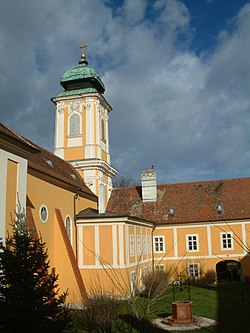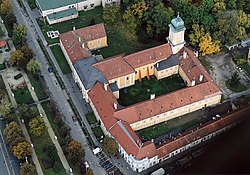Csorna (German: Gschirnau, Croatian: Černja) is a small town of 10,000 people (2021) and a thermal spa in Győr-Moson-Sopron County. This article also covers the surrounding district of the same name.
Understand
[edit]
Csorna is located on a plain between Győr and Sopron.
History
[edit]The first Hungarian mention of Csorna was in 1226, but archaeologists have found remains of Romans, other peoples, at the end of Hungarians around 900. Presumably from 1180 Premonstratensian monks lived there. During the anti-Turkish battles the town suffered greatly, but the Turks did not hold the place, only they destroyed it. During socialism due to the proximity of Austria the city visits by Hungarians caused difficulties.
Jewish community
[edit]Jews first settled in the town in the second half of the 18th century, at the invitation of the estate owner, count Eszterhazy. The majority were engaged in commerce, while there were some industrialists. The community was organized in 1853. The synagogue was built in 1854. In 1885 land was obtained for a cemetery and a Khevra Kadisha was established. There were also a school, Talmud Torah and charitable institutions. In 1930 the community numbered 795 Jews.
In 1941 Jewish males were conscripted for forced labour. In May 1944 a ghetto was set up in Csorna, in which the Jews from the surrounding area were also confined. On 18 June they were all sent to the ghetto in Sopron, and on 5 July they were transported to Auschwitz.
After the war, some tens of survivors returned who renewed communal life. In 1955 there were 70 Jews in the area, including 22 children born after the war.
Get in
[edit]Csorna is easily accessible by road and train from Győr and Sopron. Csorna is on the main line between Győr and Sopron, in addition there are branch lines from Hegyeshalom, Szombathely and Pápa.
The nearest international airports are in Vienna and Bratislava.
Get around
[edit]See
[edit]In the town
[edit]
- 1 Premonstratensian provost. Monastery and parish church buildings date from thelate 18th and early 19th century.
- 2 Csornai Museum, Szent István tér 34. A collection presenting the historical and ethnographic values of Rábaköz.
- Lutheran Church
- Church of the Assumption of Mary. with a monastery and a pilgrimage site, the tower is 35 meters high
- Sacred Heart of Jesus Parish church. (1938). It has frescoes by Nagy Sándor ("Alexander the Great").
In the district
[edit]
- 3 Dör (direct bus from Csorna and Győr). Virgin Mary Parish Church (1714, Baroque style), Saint Anthony of Padua Chapel (1899), Local history and ethnography collections in the Country House (Szabadság utca 54). Past the Fertő-Hanság National Park




- 4 Egyed (by train Pápa (23 km), Csorna (14 km)). Stern (former Festetics) mansion (18th century, baroque, Loc.:Árpási utca,) and its yard with a more than two hundreds years old Pagoda Tree, Roman Catholic Church (built in 1733 in Baroque style, rebuilt in neo-baroque style in 1933).



- 5 Magyarkeresztúr (By train Csorna 12 km or Szombathely 60 km). Local history exhibition




- 6 Szany (18 km south of Csorna, by train Pápa (19 km), Csorna). Roman Catholic Church (1767, 1867), St. Anne's Chapel (Szent Anna-kápolna, 1753-1901), Bishop's Castle (Village museum and library, Address: Kossuth Lajos u. 2). To do: walking in „Eger-Forest" and Móric Forest



- 7 Vág (S of Csorna). Local history collection.



Do
[edit]
In the town
[edit]- The association football (soccer) team Csornai SE competes in the Nemzeti Bajnokság III
- Thermal Bath and Camping[dead link], (Thököly u. 52., Daily 09:00-19:00. Tickets: full price/reduced Ft 1200/700-1000)
- Earth Island part of the Hansag-Neusiedl National Park (Fertő-Hanság Nemzeti Park)
Events:
- Jan 1: firework, concerts
- Feb 1: folklore dance evening
- Jul Aug: Music Pavilon
In the district
[edit]Buy
[edit]Eat
[edit]Drink
[edit]Sleep
[edit]In the town there are four pensions and guesthouses.

